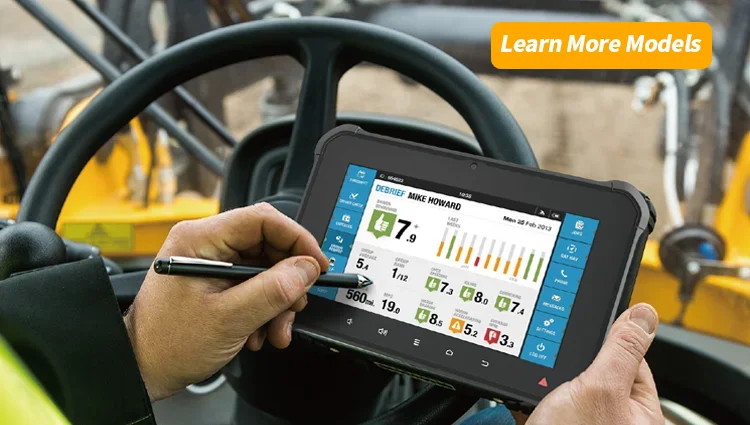Home > Blog > What is vehicle fleet management? How to manage a fleet of vehicles?
What is vehicle fleet management? How to manage a fleet of vehicles?
Time: 2025-05-14 Editor: Hitekon Rugged Vehicle Tablet Rugged Vehicle Tablet Manufacturer
Understanding Vehicle Fleet Management
Vehicle fleet management refers to the comprehensive process of overseeing, organizing, and coordinating a company’s vehicle fleet. It is a strategic function involving vehicle acquisition, maintenance, tracking, cost control, driver management, and compliance. Effective fleet management ensures operational efficiency, cost savings, and regulatory compliance, while enhancing driver safety and customer satisfaction.
Companies with a significant number of vehicles—such as logistics providers, delivery companies, taxi services, and government agencies—require robust fleet management systems to optimize productivity and minimize risks.

Key Components of Vehicle Fleet Management
1. Fleet Tracking and Telematics
Modern fleet management heavily relies on GPS tracking and telematics systems to monitor real-time vehicle location, driver behavior, fuel usage, and engine diagnostics. These systems help:
- Improve route planning
- Reduce fuel consumption
- Identify inefficient driving habits
- Ensure asset security
By integrating telematics, companies gain actionable insights and boost overall fleet efficiency.
2. Vehicle Maintenance and Inspections
Scheduled maintenance is critical to ensure fleet reliability and reduce unplanned downtime. Fleet managers must:
- Implement preventive maintenance schedules
- Monitor vehicle health indicators
- Conduct regular safety inspections
- Use fleet management software for automated alerts
Neglecting maintenance leads to higher repair costs, reduced vehicle lifespan, and regulatory penalties.
3. Fuel Management
Fuel is often the largest operational expense in fleet management. To optimize fuel efficiency, companies should:
- Use fuel cards to monitor transactions
- Analyze fuel consumption trends
- Set fuel efficiency benchmarks
- Monitor idling time and route efficiency
Advanced systems integrate with telematics to highlight areas of fuel waste and promote eco-driving.
4. Driver Management and Safety
Drivers are the most critical asset in fleet operations. Managing them effectively includes:
- Driver training programs focused on safety and efficiency
- Monitoring driver behavior (speeding, harsh braking, etc.)
- Managing working hours to comply with regulations
- Implementing reward systems for safe driving
Safety-focused driver management reduces accident rates, insurance premiums, and vehicle wear and tear.
5. Vehicle Lifecycle Management
Fleet management also encompasses the entire lifecycle of a vehicle—from acquisition to disposal. Key tasks include:
- Choosing the right vehicles for operational needs
- Negotiating favorable purchase or lease terms
- Determining optimal replacement schedules
- Maximizing resale value through proper documentation and upkeep
Lifecycle planning ensures that fleets remain cost-effective and technologically up to date.
6. Compliance and Regulatory Adherence
Fleet operations must adhere to multiple local and international laws. Compliance areas include:
- Licensing and registration
- Insurance and liability coverage
- Driver hours of service (HOS)
- Vehicle emissions standards
- Safety regulations
Failing to comply can result in fines, license suspensions, and reputation damage.

How to Manage a Fleet of Vehicles Effectively
Step 1: Set Clear Fleet Objectives
Begin with specific, measurable goals for your fleet. These may include:
- Reducing operational costs by a certain percentage
- Minimizing vehicle downtime
- Enhancing driver retention
- Improving delivery punctuality
Clearly defined KPIs will serve as benchmarks for success.
Step 2: Invest in Fleet Management Software
A centralized fleet management system (FMS) is essential for:
- Real-time vehicle tracking
- Maintenance scheduling
- Fuel usage monitoring
- Driver behavior analytics
- Generating compliance reports
Cloud-based platforms offer scalability, remote access, and automated data analysis for decision-making.
Step 3: Standardize Processes and Policies
Establish uniform policies for:
- Vehicle usage
- Maintenance responsibilities
- Accident reporting procedures
- Fuel card usage
- Safety protocols
Standardization leads to consistency, transparency, and accountability across the fleet.

Step 4: Prioritize Preventive Maintenance
Use data analytics to schedule timely:
- Oil changes
- Tire rotations
- Brake inspections
- Battery replacements
Preventive care reduces breakdowns and extends vehicle longevity.
Step 5: Analyze Data for Continuous Improvement
Regularly review:
- Fuel efficiency reports
- Driver performance dashboards
- Maintenance logs
- Route optimization results
Identify inefficiencies, make informed adjustments, and continuously optimize fleet performance.
Step 6: Focus on Driver Engagement and Retention
Ensure drivers feel valued and motivated through:
- Transparent communication
- Feedback mechanisms
- Competitive compensation
- Safety bonuses and rewards
- Career development opportunities
A satisfied driver is more likely to uphold company standards and reduce turnover.
Step 7: Plan for Scalability
Fleet needs change as businesses grow. Plan ahead by:
- Evaluating vehicle acquisition strategies
- Expanding software capabilities
- Training staff for larger operational scales
- Integrating automation and AI tools
A scalable fleet strategy supports long-term success.

Benefits of Professional Fleet Management
- Cost Efficiency: Optimize fuel, maintenance, and administrative expenses.
- Enhanced Safety: Reduce accidents, insurance claims, and liability risks.
- Regulatory Compliance: Stay up to date with legal requirements and documentation.
- Operational Transparency: Gain full visibility into your fleet’s performance.
- Customer Satisfaction: Ensure timely deliveries and high service quality.
Emerging Trends in Fleet Management
- Electric Vehicle (EV) Adoption: Reduced emissions and operational costs.
- AI and Machine Learning: Predictive maintenance and real-time analytics.
- Mobility-as-a-Service (MaaS): On-demand fleet sharing and utilization.
- Blockchain in Logistics: Transparent and secure fleet transactions.
- Integration with IoT Devices: Enhanced vehicle and cargo monitoring.
Conclusion
Effective vehicle fleet management is no longer a luxury—it’s a necessity for any organization reliant on transportation. By leveraging technology, implementing smart policies, and focusing on driver engagement, companies can significantly enhance operational efficiency and reduce costs. The future of fleet management is digital, data-driven, and increasingly sustainable.
Previous:
MDM Solutions Explained: 7 Powerful Reasons Your Business Needs One Now
Next:
How to Choose the Best Rugged Android Tablet for Tough Environments
Copyright © 2025.Hitekon Rugged Vehicle Tablet All rights reserved.
Public Transportation, Taxi Dispatch, Mining, Forklift Safety, Fleet Management, Precision Agriculture





